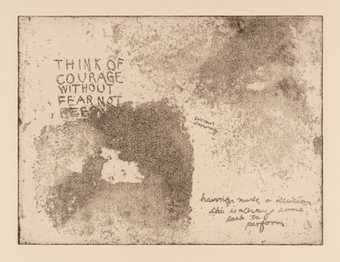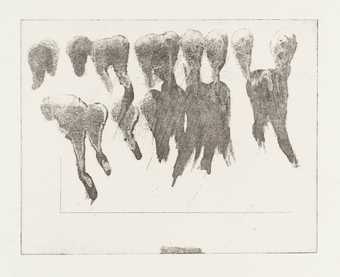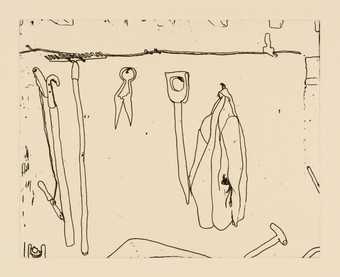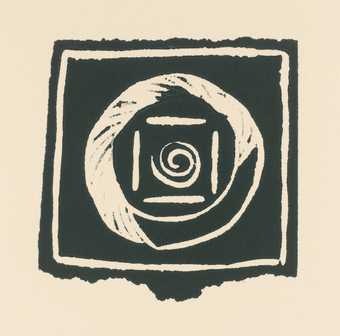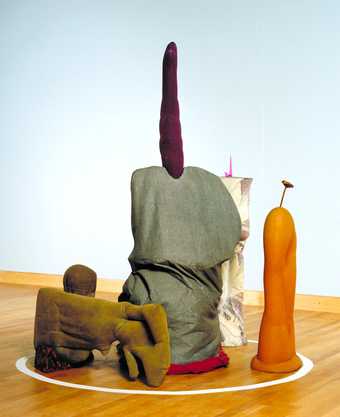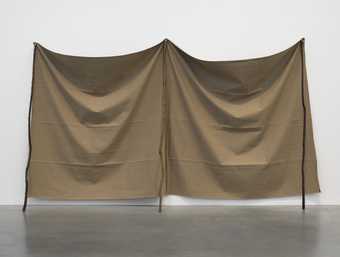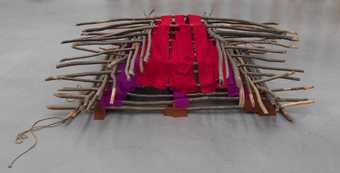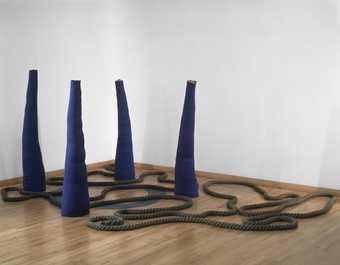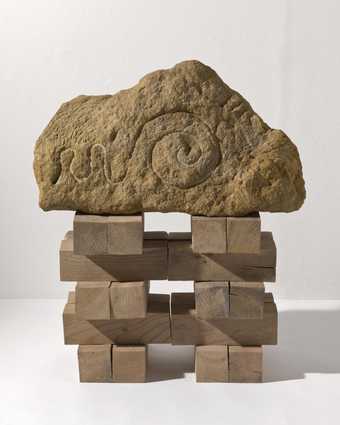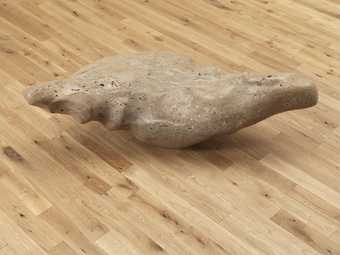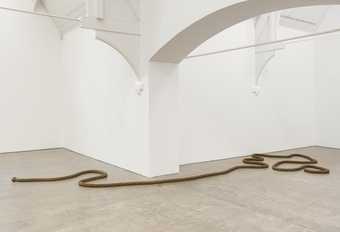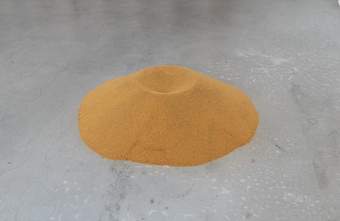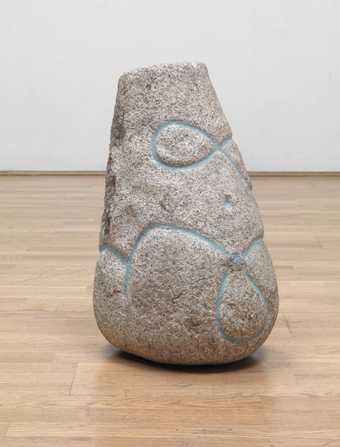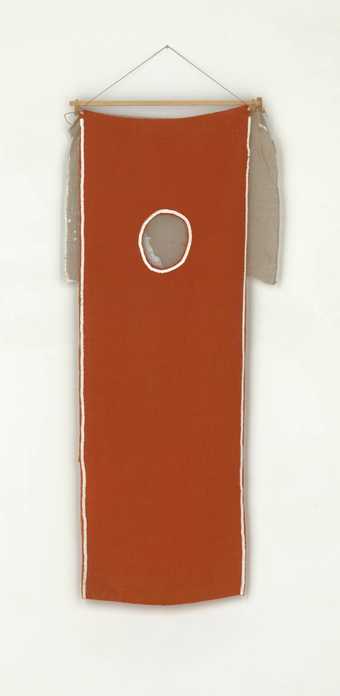- Artist
- Barry Flanagan 1941–2009
- Medium
- Rope
- Dimensions
- 67 × 67 × 39080 mm (replica - used for display)
67 × 67 × 18290 mm (original - archived) - Collection
- Tate
- Acquisition
- Purchased 1976
- Reference
- T02063
Summary
Rope (Gr 2Sp 60) 6’67 is a length of thick sisal rope that the artist has dyed an uneven shade of green. Although Rope (Gr 2Sp 60) 6’67 is an independent artwork, it is usually displayed alongside two other sculptures by Flanagan also in Tate’s collection: Ringl 1’67 1967 (Tate T02062) and Four Casb 2’67 1967 (Tate T02061). While these works can be exhibited separately, the artist considers this to be ‘less of a sculptural statement than the three of them together’, adding that ‘the three together have a certain success’ (conversation with a Tate curator, 1976). Four Casb 2’67 comprises four blue conical canvas sacks filled with sand. The bags were made from pre-dyed cotton duck and were fabricated by the artist without pattern or drawings. Each time Four Casb 2’67 is displayed, the sacks are re-filled by pushing sand into each bag by hand. This mode of construction involves an exploration of the relation between two substances, the canvas and the sand. Their mutual support, by which the sand holds up the canvas while the canvas contains the sand, transforms shapeless pieces of fabric and grains of sand into elegant, tapering uprights. Ringl 1’67 is a piece of blue linoleum cut into the shape of a ring which rests flat on the floor. Rope (Gr 2Sp 60) 6’67 forms a serpentine line on the ground that subtly connects the various components of the three works. Each title is the abbreviation of a technical description and derives from a system of annotation that Flanagan developed, influenced by the writings of the dramatist and poet Alfred Jarry (1873-1907). Four Casb 2’67 can be decoded as ‘Four canvas sand bags number two 1967’, while Rope (Gr 2Sp 60) 6’67 derives from ‘Rope green two spaces sixty feet number six 1967’ and Ringl 1’67 is abbreviated from ‘Ring lino number one 1967’.
All three works were made in London a year after Flanagan finished his studies at St. Martin’s School of Art where he had attended the advanced sculpture course for two years. Among the teachers at St. Martin’s at the time were Anthony Caro (b.1924), Phillip King (b.1934) and William Tucker (b.1935), all of whom were making predominantly rigid structures in steel or plastic. Caro’s teaching methods were celebrated for encouraging an atmosphere of discussion and experiment and a discipline of doubt and enquiry. In an open letter to his tutor in 1965, Flanagan provided a rationale for his practice: ‘Rejection has always been a motivation for me ... Is it that the only useful thing a sculptor can do, being a three dimensional thinker and therefore one hopes a responsible thinker, is to assert himself twice as hard in a negative way ... This is my dilemma’ (quoted by Graham Beal in A Quiet Revolution: British Sculpture since 1965, exhibition catalogue, Museum of Contemporary Art, Chicago 1987, pp.92-94). In explicit contrast to his St. Martin’s mentors, Flanagan began to work with soft materials, including sand and cloth, and to investigate the ways in which these materials find their own form and can be influenced by simple manual activities such as pouring, stuffing, folding and stacking. His divergence from the welded structures of Caro could not have been clearer. He deliberately questioned the convention that sculptures should be rigid and permanently fixed by making works that could never be replicated exactly on different occasions. For example, each time sand is poured into a fabric container it results in a slightly different form; each time a rope is cast down on the floor it creates a new line.
Four Casb 2’67, Ringl 1’67 and Rope (Gr 2Sp 60) were first shown together at the ‘Biennale des Jeunes’ in Paris in 1967, and Flanagan considered them to be the culmination of his work at that time. In an interview three years later, Flanagan referred to their significance: ‘The three pieces together challenged my assumption that they were autonomous. As a result of having made them and of having shown them together, I became interested in their interrelationships.’ (Quoted in ‘Sculpture Made Visible: Barry Flanagan in discussion with Gene Baro’, Studio International, CLXXVII, 1969, p.123.)
As he suggests, the individual identity of each piece, its autonomy, is negated when the works are shown together. There is a shift in Flanagan’s work and thinking around this time towards an emphasis on process, the actual making of the work, rather than its status as a fixed, discrete object. With these sculptural concerns, Flanagan had much in common at this point with his American contemporary, Robert Morris (b.1931), whose essay ‘Anti Form’ (Artforum, 6:8, April 1969, pp.33-5) provided an influential critique of preconceived form in sculpture.
Further reading
Barry Flanagan, exhibition catalogue, The British Council, London 1982, p.9, 18-19, reproduced p.9.
Barry Flanagan: A Visual Invitation, exhibition catalogue, Laing Art Gallery, Newcastle 1987, p.34, reproduced p.37.
Barry Flanagan, exhibition catalogue, Van Abbemuseum, Eindhoven 1977, reproduced [p.20].
Helen Delaney
September 2002
Does this text contain inaccurate information or language that you feel we should improve or change? We would like to hear from you.
Display caption
Flanagan wanted to show the sculptural properties of everyday things. In the mid-1960s, when he was a student in London, the prevailing tendency was for sculptors to weld together vividly coloured metal structures. By contrast, Flanagan began to explore soft and malleable materials that would change their configuration in every installation. Rope (Gr 2sp 60) 6 '67 is made with industrial rope which he dyed green, section by section, in his bath. Originally the rope crossed from one room to another but it was also exhibited in a single space.
Gallery label, April 2009
Does this text contain inaccurate information or language that you feel we should improve or change? We would like to hear from you.
Catalogue entry
T02063 ROPE (GR 2SP 60) 6'67 1967
Not inscribed
Sisal rope, 2 5/8 × 2 5/8 × 1539 (6.5 × 6.5 × 3909)
Purchased from the Rowan Gallery (Grant-in-Aid) 1976
Exh: Cinquième Biennale de Paris, Musée d'Art Moderne de la Ville de Paris, September–November 1967 (Grande-Bretagne 14, repr.); Arte Inglese Oggi, Palazzo Reale, Milan, February–May 1976 (Barry Flanagan I, repr. and in colour p.243); Barry Flanagan, Sculpture 1966–1976, Van Abbemuseum, Eindhoven, June–July 1977, Arnolfini Gallery, Bristol, July–August 1977 and Serpentine Gallery, November 1978–January 1979 (works not numbered, repr.)
Lit: ‘Barry Flanagan’ in Studio International, CLXXIV, 1967, pp.98–9, colour repr. p.99, and in hessian bag p.98; Charles Harrison, ‘Barry Flanagan's sculpture’ in Studio International, CLXXV, 1968, p.268; Barry Flanagan, 'From notes ‘67/8’ in Studio International, CLXXVII, 1969, p.37; Gene Baro, ‘Sculpture made visible’, discussion with Barry Flanagan in Studio International, CLXXVII, 1969, p.123, repr. p.123 and p.124
Repr: Arnolfini Review, July–August 1977, p.5; Current British Art, catalogue of Arts Council exhibition, Hayward Gallery, May–September 1977, pp.96–7
The three works, catalogued here together [T02061, T02062, T02063], were all made in 1967 in Flanagan's home in Hungerford Road, London NW17, and in his studio in Lambeth Street. Before being exhibited at the Paris Biennale they were assembled to be photographed in the studio he shared with Alan Gouk below a chemist's shop in Kilburn. The canvas bags (T02061) were made from pre-dyed cotton duck purchased from Russell and Chapple, and were fabricated without drawings, pattern or template. The bags are filled with dry sand for display, each bag holding approximately one quarter of a ton of sand. A plastic disc is placed at the base of each bag to prevent the sand from trickling out in the early stages of filling. The ring (T02062) was cut from blue linoleum. The original piece of linoleum was damaged after exhibition in Milan (op. cit) and was replaced by Flanagan on acquisition by the Tate, the new piece cut out by using the old piece as a template. The sisal rope (T02063) was purchased by Flanagan from British Ropes (‘They had won a Queen's Award for Industry’) and was dyed green by him. He used Dylon hot dyes in a mixture of several colours, working in sections because it was too large to fit in the bath. The colours for each piece were chosen with regard to the strength or value of the colour rather than the hue. Flanagan referred to the canvas as simply a ‘blue’ and to the particular linoleum as a ‘nice dark blue’ (conversation 13 December 1976).
The titles for the works were given as part of a system of annotation and description that Flanagan used. Words were made from selected (normally initial) letters taken from the descriptive words for the component parts of each work. The system was derived from the writings of Alfred Jarry, and from his current interest in concrete poetry. The full titles are:
T02061 Four canvas sand bags number two 1967
T02062 Ring lino number one 1967
T02063 Rope green two space sixty feet number six 1967
The system was never completely consistent but generally covered the shape, materials (sometimes colour), number and year of the work.
The works made in 1967 were an extension from the work of the previous two years. In 1965 Flanagan had characteristically made sculptures with coloured canvas bags filled with plaster (‘aaing i gui aa’, T01120) and in 1966 he made sculptures out of single materials (e.g. rope, sand, glass) in which a simple act altered the material as found: a dent in a pile of sand, a ring removed from a glass sheet, or a rope knotted and twisted. ‘4 Casb 2'67’ was the second work in which canvas bags were filled with sand. In comparing this work with T01120, the artist stressed the similarity in the grouping of separately made objects, but also the difference in the lack of ‘objectness’ of the later work. This lack of ‘objectness’, using canvas and sand, had in part been a technical solution to the problem of moving the heavy plaster sculptures (Gene Baro, Studio International, op. cit.), as sand could be obtained anywhere and used to fill the bags. The artist commented that this had not proved to be true, as it was quite difficult to get the right sort of dry sand anywhere. It was also an exploration of the relation between the canvas and the sand (by which the sand supports the canvas and the canvas supports the sand), based on Flanagan's knowledge of ‘soft shuttering’, a process used in building construction to mould concrete while it sets hard. Both this relation and the physical process of installing the work (which Flanagan considers to be an important aspect of the work), separate ‘4 Casb 2'67’ from the earlier plaster sculptures. ‘Ringl I’ 67' was the first ring cut from linoleum, and the first positive ring, as earlier rings had been the space left when a ring had been removed from a substance. ‘Rope (Gr2Sp60) 6'67’ was selected to run between two spaces, but the artist later realised that it worked well contained within a single space, which is how it was exhibited in Milan in 1976. It was also photographed in 1967 (Studio International, op. cit.) contained within a hessian bag.
All three works are independent pieces of sculpture and were made separately. They were, however, first shown together in one space (they were listed as one work in the Arte Inglese Oggi catalogue) and were together a culmination of
Flanagan's work at the time. The statement that Flanagan published (Studio International 1969) made clear that while rejecting the notion of an ‘environmental’ art, he was interested in the total view of them together: ‘It is fortuitous or interesting that they negate their specific identities and work together in such a way’. When the works were first photographed, the floor of the studio was covered with more of the same sand that had filled the bags. This was in order both to counteract any uneveness in the floor and also to unite the separate works in direct relation to the space containing them. After the photography and the installation in Paris, this was dropped. The artist explained that this small part of the works had been ‘eclipsed’ by the earth-filled gallery made by the American artist, Walter de Maria (September–October 1968, Galerie Heiner Friedrich, Munich, and was no longer relevant to the sculptural concerns of these works. In some notes written at the time of making the works Flanagan further explored ‘inter-relatedness’: ‘Without the literary investiture of identity, things seen (matter/stuff) become truly visual in the whiteness of space/light (the medium of perception). Then a larger visual order may be articulated, unframed by literary process.’ (Studio International, 1969.) He has continued his interest in architectural setting (he was originally an architectural student in Birmingham) with works composed of projected light and of piled sand and stacks. One of the three works has been exhibited individually: ‘4 Casb 2'67’ in Tokyo in 1970.
The artist recognises that the arrangement of the columns (which have no set ground-plan) and of the works in relation to each other is open to the interpretation of the installer on each occasion. The minimum size room in which they may be shown is one in which the sides are no shorter than the height of one column. After acquisition of the works by the Tate, the artist wrote a short statement (dated 18 June 1976) which referred to his earlier statement in Studio International and went on to say: ‘As components of a sculptural language their exhibition is, as plays and music are interpreted after authorship at a later date, open to the responsible and creative interpretation dictated by time and place given normal consideration to the authorship’. In discussion (13 December 1976) Flanagan made it clear that there could be no written ‘rules’ for the installation of the three works. (The Tate does have careful instructions for the display of other works by Flanagan.) He hoped that the installer would take into account the architecture in which they were being displayed, and the ways in which the work had been installed previously (for which the Tate archive has photographs).
Published in:
The Tate Gallery 1976-8: Illustrated Catalogue of Acquisitions, London 1979
Explore
- abstraction(8,615)
-
- non-representational(6,161)
-
- irregular forms(2,007)
- tools and machinery(1,287)
-
- rope(93)
You might like
-
Barry Flanagan Think of Courage (without Fear not)
1972, reprinted c.1983 -
Barry Flanagan Abstract
1972 -
Barry Flanagan The Wren’s Nest
1972, published 1983 -
Barry Flanagan Motif
1975 -
Barry Flanagan aaing j gni aa
1965 -
Barry Flanagan june 2 ‘69
1969 -
Barry Flanagan no. 5 ‘71
1971 -
Barry Flanagan 4 casb 2 ‘67
1967 -
Barry Flanagan a nose in repose
1977–9 -
Barry Flanagan untitled (carving no. 13/81)
1981 -
Barry Flanagan Carving No. 2
1981 -
Barry Flanagan 2 space rope sculpture (gr 2 sp 60)
1967 -
Barry Flanagan ringn ‘66
1966 -
Barry Flanagan Cornish BuB
1979 -
Barry Flanagan flaming red
1973, 1978


